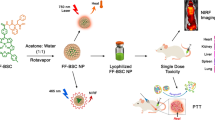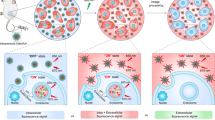Abstract
Optically active nanomaterials promise to advance a range of biophotonic techniques through nanoscale optical effects and integration of multiple imaging and therapeutic modalities. Here, we report the development of porphysomes; nanovesicles formed from self-assembled porphyrin bilayers that generated large, tunable extinction coefficients, structure-dependent fluorescence self-quenching and unique photothermal and photoacoustic properties. Porphysomes enabled the sensitive visualization of lymphatic systems using photoacoustic tomography. Near-infrared fluorescence generation could be restored on dissociation, creating opportunities for low-background fluorescence imaging. As a result of their organic nature, porphysomes were enzymatically biodegradable and induced minimal acute toxicity in mice with intravenous doses of 1,000 mg kg−1. In a similar manner to liposomes, the large aqueous core of porphysomes could be passively or actively loaded. Following systemic administration, porphysomes accumulated in tumours of xenograft-bearing mice and laser irradiation induced photothermal tumour ablation. The optical properties and biocompatibility of porphysomes demonstrate the multimodal potential of organic nanoparticles for biophotonic imaging and therapy.
This is a preview of subscription content, access via your institution
Access options
Subscribe to this journal
Receive 12 print issues and online access
$259.00 per year
only $21.58 per issue
Buy this article
- Purchase on SpringerLink
- Instant access to full article PDF
Prices may be subject to local taxes which are calculated during checkout






Similar content being viewed by others
References
Chan, W. C. W. & Nie, S. Quantum dot bioconjugates for ultrasensitive nonisotopic detection. Science 281, 2016–2018 (1998).
Storhoff, J. J., Lucas, A. D., Garimella, V., Bao, Y. P. & Müller, U. R. Homogeneous detection of unamplified genomic DNA sequences based on colorimetric scatter of gold nanoparticle probes. Nature Biotechnol. 22, 883–887 (2004).
Dolmans, D. E., Fukumura, D. & Jain, R. K. Photodynamic therapy for cancer. Nature Rev. Cancer 3, 380–387 (2003).
O’Neal, D. P., Hirsch, L. R., Halas, N. J., Payne, J. D. & West, J. L. Photo-thermal tumour ablation in mice using near infrared-absorbing nanoparticles. Cancer Lett. 209, 171–176 (2004).
Huang, X., El-Sayed, I. H., Qian, W. & El-Sayed, M. A. Cancer cell imaging and photothermal therapy in the near-infrared region by using gold nanorods. J. Am. Chem. Soc. 128, 2115–2120 (2006).
Oraevsky, A. A. Laser optoacoustic tomography for medical diagnostics: Principles. Proc. SPIE 2676, 22–31 (1996).
Oraevsky, A. A. & Karabutov, A. A. in Biomedical Photonics Handbook 2003 edn (ed. Vo-Dinh, T.) 34.1–34.34 (CRC Press, 2003).
Xu, M. & Wang, L. V. Photoacoustic imaging in biomedicine. Rev. Sci. Instrum. 77, 041101 (2006).
Wang, L. V. Multiscale photoacoustic microscopy and computed tomography. Nature Photon. 3, 503–509 (2009).
Vakoc, B. J. et al. Three-dimensional microscopy of the tumor microenvironment in vivo using optical frequency domain imaging. Nature Med. 15, 1219–1223 (2009).
Weissleder, R. & Pittet, M. J. Imaging in the era of molecular oncology. Nature 452, 580–589 (2008).
Klostranec, J. M. & Chan, W. Quantum dots in biological and biomedical research: Recent progress and present challenges. Adv. Mater. 18, 1953–1964 (2006).
Yguerabide, J. & Yguerabide, E. E. Light-scattering submicroscopic particles as highly fluorescent analogs and their use as tracer labels in clinical and biological applications: I. Theory. Anal. Biochem. 262, 137–156 (1998).
Lal, S., Clare, S. E. & Halas, N. J. Nanoshell-enabled photothermal cancer therapy: Impending clinical impact. Acc. Chem. Res. 41, 1842–1851 (2008).
Ghosh, P., Han, G., De, M., Kim, C. K. & Rotello, V. M. Gold nanoparticles in delivery applications. Adv. Drug. Deliv. Rev. 60, 1307–1315 (2008).
Lewinski, N., Colvin, V. & Drezek, R. Cytotoxicity of nanoparticles. Small 4, 26–49 (2008).
Nel, A., Xia, T., Madler, L. & Li, N. Toxic potential of materials at the nanolevel. Science 311, 622–627 (2006).
Peer, D. et al. Nanocarriers as an emerging platform for cancer therapy. Nature Nanotech. 2, 751–760 (2007).
Drain, C. M., Varotto, A. & Radivojevic, I. Self-organized porphyrinic materials. Chem. Rev. 109, 1630–1658 (2009).
Harris, J. M. & Chess, R. B. Effect of pegylation on pharmaceuticals. Nature Rev. Drug Discov. 2, 214–221 (2003).
Pasternack, R. F. & Collings, P. J. Resonance light scattering: A new technique for studying chromophore aggregation. Science 269, 935–939 (1995).
Nagayasu, A., Uchiyama, K. & Kiwada, H. The size of liposomes: A factor which affects their targeting efficiency to tumors and therapeutic activity of liposomal antitumour drugs. Adv. Drug Deliv. Rev. 40, 75–87 (1999).
Huang, L., Sullenger, B. & Juliano, R. The role of carrier size in the pharmacodynamics of antisense and siRNA oligonucleotides. J. Drug Target. 18, 567–574 (2010).
Hansen, C. B., Kao, G. Y., Moase, E. H., Zalipsky, S. & Allen, T. M. Attachment of antibodies to sterically stabilized liposomes: Evaluation, comparison and optimization of coupling procedures. Biochim. Biophys. Acta 1239, 133–144 (1995).
Lovell, J. F., Liu, T. W. B., Chen, J. & Zheng, G. Activatable photosensitizers for imaging and therapy. Chem. Rev. 110, 2839–2857 (2010).
Chen, B., Pogue, B. W. & Hasan, T. Liposomal delivery of photosensitising agents. Expert Opin. Drug Deliv. 2, 477–487 (2005).
Komatsu, T., Moritake, M., Nakagawa, A. & Tsuchida, E. Self-organized lipid-porphyrin bilayer membranes in vesicular form: Nanostructure, photophysical properties, and dioxygen coordination. Chem. Eur. J. 8, 5469–5480 (2002).
Ghoroghchian, P. P. et al. Near-infrared-emissive polymersomes: Self-assembled soft matter for in vivo optical imaging. Proc. Natl Acad. Sci. USA 102, 2922–2927 (2005).
Galanzha, E. I. et al. In vivo magnetic enrichment and multiplex photoacoustic detection of circulating tumour cells. Nature Nanotech. 4, 855–860 (2009).
Galanzha, E. I. et al. In vivo fibre-based multicolor photoacoustic detection and photothermal purging of metastasis in sentinel lymph nodes targeted by nanoparticles. J. Biophoton. 2, 528–539 (2009).
Lee, R. J. & Low, P. S. Delivery of liposomes into cultured KB cells via folate receptor-mediated endocytosis. J. Biol. Chem. 269, 3198–3204 (1994).
Park, J. et al. Biodegradable luminescent porous silicon nanoparticles for in vivo applications. Nature Mater. 8, 331–336 (2009).
Suzuki, Y., Tanabe, K. & Shioi, Y. Determination of chemical oxidation products of chlorophyll and porphyrin by high-performance liquid chromatography. J. Chromatogr. A 839, 85–91 (1999).
Kirby, C., Clarke, J. & Gregoriadis, G. Effect of the cholesterol content of small unilamellar liposomes on their stability in vivo and in vitro. Biochem. J. 186, 591–598 (1980).
Haran, G., Cohen, R., Bar, L. K. & Barenholz, Y. Transmembrane ammonium sulphate gradients in liposomes produce efficient and stable entrapment of amphipathic weak bases. Biochim. Biophys. Acta 1151, 201–215 (1993).
Ahmed, F. et al. Shrinkage of a rapidly growing tumor by drug-loaded polymersomes: pH-triggered release through copolymer degradation. Mol. Pharm. 3, 340–350 (2006).
Heidel, J. D. & Davis, M. E. Clinical developments in nanotechnology for cancer therapy. Pharm. Res. 28, 187–199 (2011).
von Maltzahn, G. et al. Computationally guided photothermal tumor therapy using long-circulating gold nanorod antennas. Cancer Res. 69, 3892–3900 (2009).
Chen, J. et al. Gold nanocages as photothermal transducers for cancer treatment. Small 6, 811–817 (2010).
Yang, K. et al. Graphene in mice: Ultrahigh in vivo tumor uptake and efficient photothermal therapy. Nano Lett. 10, 3318–3323 (2010).
Wilson, B. C. & Patterson, M. S. The physics, biophysics and technology of photodynamic therapy. Phys. Med. Biol. 53, R61–R109 (2008).
Acknowledgements
We thank B. G. Neel for editing, B. C. Wilson and C. M. Yip for insightful discussion, P. V. Turner for histopathology analysis, and E. Kumacheva and L. Tzadu for providing gold nanorods. This work was supported by grants from the Ontario Institute for Cancer Research, the Canadian Cancer Society, the Natural Sciences and Engineering Research Council of Canada, the Canadian Institute of Health Research, the Canadian Foundation of Innovation, the Joey and Toby Tanenbaum/Brazilian Ball Chair in Prostate Cancer Research, and in part from the Campbell Family Institute for Cancer Research, the Princess Margaret Hospital Foundation and the Ministry of Health and Long-Term Planning.
Author information
Authors and Affiliations
Contributions
J.F.L. and G.Z. conceived the project, interpreted the data and wrote the manuscript. J.F.L., W.C.W.C. and G.Z. planned the experiments. C.S.J. and J.F.L. carried out photothermal tumour ablation. C.S.J. carried out confocal microscopy. E.H. and J.F.L. carried out most porphysome formation, photophysical characterization and drug encapsulation. H.J. and J.F.L. carried out toxicity experiments. J.L.R. carried out electron microscopy. C.K and L.V.W. carried out the photoacoustic experiments. W.C. and J.F.L. prepared the porphysome starting materials.
Corresponding authors
Ethics declarations
Competing interests
The authors declare no competing financial interests.
Supplementary information
Supplementary Information
Supplementary Information (PDF 1453 kb)
Rights and permissions
About this article
Cite this article
Lovell, J., Jin, C., Huynh, E. et al. Porphysome nanovesicles generated by porphyrin bilayers for use as multimodal biophotonic contrast agents. Nature Mater 10, 324–332 (2011). https://doi.org/10.1038/nmat2986
Received:
Accepted:
Published:
Issue Date:
DOI: https://doi.org/10.1038/nmat2986



